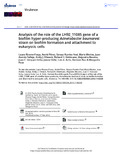Mostrar el registro sencillo del ítem
Analysis of the role of the LH92_11085 gene of a biofilm hyper-producing Acinetobacter baumannii strain on biofilm formation and attachment to eukaryotic cells
| dc.creator | Álvarez Fraga, Laura | es_ES |
| dc.creator | Pérez, Astrid | es_ES |
| dc.creator | Rumbo Feal, Soraya | es_ES |
| dc.creator | Merino, María | es_ES |
| dc.creator | Valle Turrillas, Jaione | es_ES |
| dc.date.accessioned | 2020-09-22T07:53:17Z | |
| dc.date.available | 2020-09-22T07:53:17Z | |
| dc.date.issued | 2016 | |
| dc.identifier.issn | 2150-5608 | |
| dc.identifier.uri | https://hdl.handle.net/2454/38215 | |
| dc.description.abstract | Acinetobacter baumannii is a nosocomial pathogen that has a considerable ability to survive in the hospital environment partly due to its capacity to form biofilms. The first step in the process of establishing an infection is adherence of the bacteria to target cells. Chaperone-usher pili assembly systems are involved in pilus biogenesis pathways that play an important role in adhesion to host cells and tissues as well as medically relevant surfaces. After screening a collection of strains, a biofilm hyper-producing A. baumannii strain (MAR002) was selected to describe potential targets involved in pathogenicity. MAR002 showed a remarkable ability to form biofilm and attach to A549 human alveolar epithelial cells. Analysis of MAR002 using transmission electron microscopy (TEM) showed a significant presence of pili on the bacterial surface. Putative protein-coding genes involved in pili formation were identified based on the newly sequenced genome of MAR002 strain (JRHB01000001/2 or NZ_JRHB01000001/2). As assessed by qRT-PCR, the gene LH92_11085, belonging to the operon LH92_11070-11085, is overexpressed (ca. 25-fold more) in biofilm-associated cells compared to exponential planktonic cells. In the present work we investigate the role of this gene on the MAR002 biofilm phenotype. Scanning electron microscopy (SEM) and biofilm assays showed that inactivation of LH92_11085 gene significantly reduced bacterial attachment to A549 cells and biofilm formation on plastic, respectively. TEM analysis of the LH92_11085 mutant showed the absence of long pili formations normally present in the wild-type. These observations indicate the potential role this LH92_11085 gene could play in the pathobiology of A baumannii. | en |
| dc.description.sponsorship | The results of this work have been funded by the Projects PI11/01034 to MP and PI14/00059 to MP and AB and PI12/00552 and PI15/00860 to GB, integrated in the National Plan for Scientific Research, Development and Technological Innovation 2013-2016 and funded by the ISCIII- General Subdirection of Assessment and Promotion of the Research – European Regional Development Fund (FEDER) 'A way of making Europe' and Miami University (Ohio, USA) Research Funds. The authors also thank Spanish Network for Research in Infectious Diseases (REIPI RD12/0015/0014 to GB), cofinanced by the European Development Regional Fund (EDRF) 'A Way to Achieve Europe', Instituto de Salud Carlos III, Subdirección General de Redes y Centros de Investigación Cooperativa, Ministerio de Economía y Competitividad. A.P. was financially supported by the Galician Plan for Research, Innovation and Growth (I2C Plan 2012-2016). J.A. Vallejo was financially supported by the Sara Borrell Program (ISCIII, Spain CD13/00373). The authors wish to thank grant GEIH/REIPI-Ab2010 from Instituto de Salud Carlos III - Ministerio Economía y Competitividad for providing MAR002 strain and M.I. Voskuil for pMo130. | en |
| dc.format.extent | 14 p. | |
| dc.format.mimetype | application/pdf | en |
| dc.language.iso | eng | en |
| dc.publisher | Taylor & Francis | en |
| dc.relation.ispartof | Virulence, 2016, 7(4), 443-455 | en |
| dc.rights | © 2016 The authors. Published with license by Taylor & Francis. This is an Open Access article distributed under the terms of the Creative Commons Attribution-Non-Commercial License, which permits unrestricted non-commercial use, distribution, and reproduction in any medium, provided the original work is properly cited. The moral rights of the named author(s) have been asserted. | en |
| dc.rights.uri | http://creativecommons.org/licenses/by-nc/3.0/ | |
| dc.subject | Acinetobacter baumannii | en |
| dc.subject | Attachment | en |
| dc.subject | Biofilm | en |
| dc.subject | Pathogenicity | en |
| dc.subject | Pili | en |
| dc.subject | Virulence | en |
| dc.title | Analysis of the role of the LH92_11085 gene of a biofilm hyper-producing Acinetobacter baumannii strain on biofilm formation and attachment to eukaryotic cells | en |
| dc.type | info:eu-repo/semantics/article | en |
| dc.type | Artículo / Artikulua | es |
| dc.contributor.department | IdAB. Instituto de Agrobiotecnología / Agrobioteknologiako Institutua | es |
| dc.rights.accessRights | info:eu-repo/semantics/openAccess | en |
| dc.rights.accessRights | Acceso abierto / Sarbide irekia | es |
| dc.identifier.doi | 10.1080/21505594.2016.1145335 | |
| dc.relation.publisherversion | https://doi.org/10.1080/21505594.2016.1145335 | |
| dc.type.version | info:eu-repo/semantics/publishedVersion | en |
| dc.type.version | Versión publicada / Argitaratu den bertsioa | es |
Ficheros en el ítem
Este ítem aparece en la(s) siguiente(s) colección(ones)
La licencia del ítem se describe como © 2016 The authors. Published with license by Taylor & Francis. This is an Open Access article distributed under the terms of the Creative Commons Attribution-Non-Commercial License, which permits unrestricted non-commercial use, distribution, and reproduction in any medium, provided the original work is properly cited. The moral rights of
the named author(s) have been asserted.




